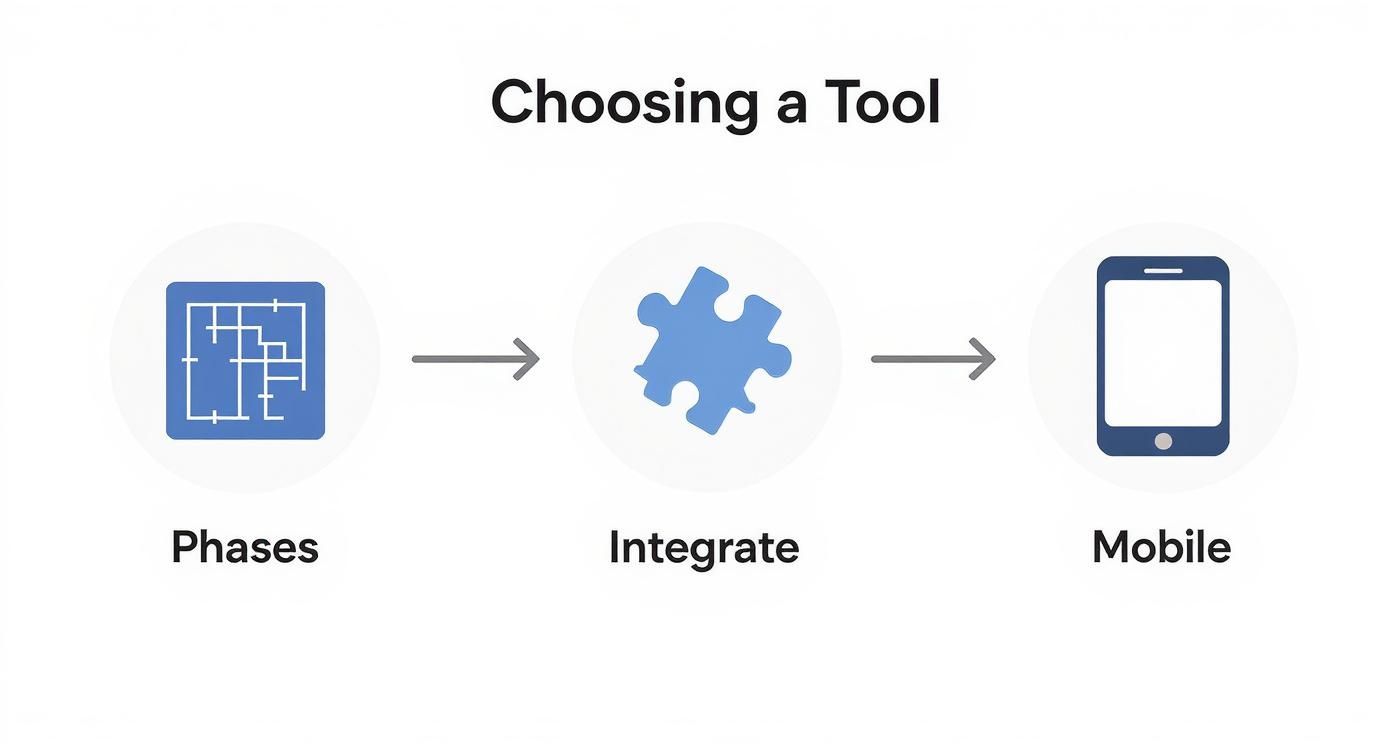- Time Tracking for Architects That Works
- Why Generic Time Tracking Fails Architecture Firms
- The Disconnect Between Workflow and Software
- Choosing the Right Time Tracking Tool for Your Firm
- Beyond Simple Timers: Core Features You Absolutely Need
- Essential vs. Nice-to-Have Software Features for Architects
- All-in-One Platforms vs. Standalone Tools
- Building Your Firm’s Time Tracking Language
- Earning Team Buy-In Without the Micromanagement Vibe
- Run a Pilot Program Before Going Firm-Wide
- Turning Time Data Into Smarter Decisions
- Key Reports That Reveal the Full Story
- From Data Points to Actionable Insights
- Overcoming Common Time Tracking Hurdles
- Handling Team Resistance
- Tracking What Really Matters
- Unpacking the Common Questions Around Time Tracking
- How Do We Get Our Creative Team to Actually Use the Software?
- What Is the Best Way to Track Time for Fixed-Fee Projects?
- Should We Track Non-Billable Time?
- How Often Should Our Team Submit Timesheets?
Time Tracking for Architects That Works
Let’s be honest, most architects see time tracking as a tedious chore. It’s that annoying bit of admin that pulls you away from the creative work you actually love. We’ve all been there, trying to reconstruct a week on a Friday afternoon.
But what if the problem isn’t time tracking itself, but the generic, one-size-fits-all tools we’re often forced to use? For architects, effective time tracking is about so much more than just logging hours; it’s a powerful tool for business intelligence that can genuinely make your work life easier.
Why Generic Time Tracking Fails Architecture Firms
Standard time tracking software just doesn’t get how architecture firms work. It’s usually built for a world of simple, linear tasks, but an architectural project is anything but simple. It’s a complex ecosystem of distinct phases—from schematic design right through to construction administration—each with its own rhythm and resource demands.
Generic tools completely fail to capture this nuance. They might let you log hours against a project, but can they tell the difference between a billable design charrette and the non-billable time you poured into a competition entry? Almost never. And this is where the problems start.
The Disconnect Between Workflow and Software
The day-to-day workflow in an architecture practice is unique. You might have one person juggling three projects at once—one in design development, another stuck in permitting, and a third wrapping up construction details. A generic system that just asks for “hours worked” on “Project X” is useless for understanding where your team’s effort is really going.

This disconnect creates some serious pain points:
- Inaccurate Bids: Without detailed historical data on how long each phase actually takes, your future proposals are based on guesswork, not evidence. This is a recipe for losing money. For instance, you might budget 80 hours for Design Development, but if you consistently spend 120, your proposals will always be off.
- Hidden Scope Creep: It’s incredibly difficult to spot when a client’s “small revisions” in the design development phase have eaten up all the hours you’d allocated for construction documents. You feel the pressure, but you can’t point to the specific cause.
- Poor Resource Planning: You can’t effectively manage workloads if you don’t have a clear picture of who is spending time on which specific project stages. It leads to burnout for your star players and missed deadlines for your clients.
“A generic tool treats all hours as equal. An architect knows that an hour of conceptual design has a different value and impact than an hour of administrative follow-up. Your software should understand that, too.”
Ultimately, getting time tracking right is fundamental to ensuring your firm is profitable, your clients are happy, and your operations are efficient. Digital solutions designed specifically for architects help capture precise data on billable hours and task-specific work, which almost always leads to major improvements in workflow and client trust.
You can learn more about improving your firm’s processes by exploring our complete guide to project management for architects. This kind of foundational knowledge is key to running a successful practice. When your time tracking aligns with your project phases, it stops being a chore and becomes a serious strategic advantage.
Choosing the Right Time Tracking Tool for Your Firm
Finding a time tracking tool that actually gets the architectural workflow can feel like a wild goose chase. There are a million options out there, but most of them just add another layer of complexity instead of making your life easier. The real trick is to look past the slick marketing and zero in on features that solve the day-to-day problems of running a design firm.
Think about it like a client discovery meeting. You wouldn’t design a building without first understanding the core problems. Do the same here. What are your biggest headaches? Inaccurate fee proposals? Scope creep blowing up your design development phase? Or is it just the sheer administrative pain of chasing down timesheets every Friday?
Beyond Simple Timers: Core Features You Absolutely Need
A basic start-stop timer just won’t cut it for an architecture firm. We need a system built around the anatomy of a project. When you’re sitting in on a software demo, don’t get distracted by the bells and whistles—focus on the fundamentals.
Here’s what your checklist should look like:
- Phase-Based Tracking: This is non-negotiable. The software must let your team log hours against specific project phases like Schematic Design (SD), Design Development (DD), and Construction Administration (CA). Without this, you’re flying blind when it comes to understanding where your team’s effort is really going.
- Seamless Integrations: Your time tracking tool shouldn’t be a data island. It needs to play nicely with your project management and accounting software, whether that’s QuickBooks or Xero. This avoids the soul-crushing task of double data entry and keeps your financial reporting accurate.
- Mobile Accessibility: Let’s be real—your team isn’t chained to their desks. They’re at client meetings, on-site, or doing inspections. Mobile access is essential for capturing hours accurately in the moment. Imagine logging a two-hour site visit right from your phone instead of trying to remember it days later.
To help you distinguish the critical from the convenient, here’s a breakdown of software features you’ll encounter.
Essential vs. Nice-to-Have Software Features for Architects
| Feature Type | Specific Feature | Why It Matters for Architects |
|---|---|---|
| Essential | Project & Phase Tracking | Allows time to be logged against specific project stages (SD, DD, CA), which is fundamental for fee proposals and profitability analysis. |
| Essential | Mobile Time Entry | Crucial for architects who split time between the office and job sites, ensuring all hours are captured accurately and promptly. |
| Essential | Integration with Accounting Software | Connects to tools like QuickBooks or Xero to streamline invoicing and eliminate manual data entry, reducing errors. |
| Essential | Customizable Reports | Generates insights on project profitability, team utilization, and phase-specific budget performance to inform future bids. |
| Nice-to-Have | Built-in Invoicing | Creates invoices directly from tracked time within the platform, saving administrative steps but can be handled by integrated accounting software. |
| Nice-to-Have | Expense Tracking | Allows staff to log project-related expenses like travel or printing. Useful for consolidated project accounting but not a core time-tracking need. |
| Nice-to-Have | Resource Scheduling | Provides tools to forecast team capacity and assign staff to future projects. Great for larger firms managing complex workloads. |
| Nice-to-Have | Advanced AI Analytics | Uses AI to predict project overruns or suggest resource allocation. Powerful, but more advanced than what most small-to-mid-sized firms need initially. |
Focusing on the “essentials” first will ensure you get a tool that solves your immediate problems without overwhelming your team.
All-in-One Platforms vs. Standalone Tools
The market basically splits into two camps: simple, standalone timers and comprehensive firm management platforms. The simple timers are tempting because they’re cheap (or even free), but their limitations become obvious almost immediately. They just don’t offer the project-level detail you need to generate any meaningful business insights.
On the other end of the spectrum, all-in-one platforms bundle time tracking with project management, invoicing, and deep financial reporting. Sure, the initial investment is higher, but these systems become the single source of truth for your entire firm. They can tell you your exact profitability on a per-project or even per-phase basis, turning your time data from a simple billing tool into a powerful strategic asset.
For an architect, time isn’t just a metric for billing—it’s your primary inventory. The right tool helps you manage that inventory with the same precision you apply to a building’s design.
Ultimately, the goal is to find a system that feels like a natural extension of how you already work. By keeping these core architectural needs front and center, you can cut through the noise and pick a tool that brings clarity and control to your firm.
For a deeper look at what a modern, integrated system can do, check out the features of a time tracking feature for professional services. Seeing how all these elements come together will give you a much clearer picture of what to look for in a solution that will genuinely support your firm’s growth.
So, you’ve picked out your new time tracking software. That’s a huge step, but the real work starts now. Even the most powerful tool is just expensive shelfware if your team doesn’t actually use it—or worse, doesn’t use it correctly.
A successful rollout isn’t about sending a memo and hoping for the best. It’s about building a thoughtful framework that feels like a shared upgrade, not a top-down mandate. It needs to make sense within your firm’s unique architectural workflow.
Building Your Firm’s Time Tracking Language
First things first: you need to define your project phases and task codes. This isn’t just a boring admin task; it’s about creating a common language for how your firm talks about and measures its work. For this to stick, the codes have to be intuitive and directly mirror the things your team does every single day.
Vague buckets like “Design” or “Meetings” are useless. They won’t give you the data you need to make smarter decisions. You have to get specific and align your codes with the actual phases of a project.
Here’s a practical example:
- Schematic Design (SD): Don’t just lump it all together. Break it down into real-world tasks like SD-ClientMeeting, SD-ConceptSketching, or SD-ZoningAnalysis.
- Design Development (DD): This phase has its own unique activities. Think about creating codes like DD-Modeling, DD-ConsultantCoordination, and DD-MaterialsResearch.
- Construction Documents (CD): This is where things get really detailed. Your codes should reflect that. Use granular codes like CD-Detailing, CD-SpecsWriting, and CD-QualityControl.
- Construction Administration (CA): Make sure you can distinguish between on-site work and office work with codes like CA-SiteVisit, CA-RFIs, and CA-SubmittalReview.
When you get this granular, your time tracking data transforms from a simple timesheet into a powerful analytical tool. You can finally see exactly which activities are eating up the most resources and adjust your fees and project plans for the next job.
This flow shows how the whole system comes together—from structuring your project phases correctly to making sure the tool is accessible for your team on the go.

As you can see, a system’s success depends just as much on how you structure it (the phases and tasks) as it does on its technical features (like integrations and mobile access).
Earning Team Buy-In Without the Micromanagement Vibe
This is the part where so many firms stumble. If your team thinks time tracking is just a digital leash to monitor their every move, they will fight it every step of the way. You have to frame it as a tool for their benefit—a way to protect their time, prove the need for more help, and make sure workloads are actually balanced.
The demand for these tools is exploding for a reason. The time tracking software market, which is essential for professions like ours, was valued at around USD 3.8 billion in 2025 and is expected to rocket to USD 16.1 billion by 2035. That growth tells you how vital accurate time data has become for profitability. You can dig into more of the numbers and see the global trends in time tracking software.
Key Takeaway: You have to sell this as a tool for project clarity, not employee surveillance. When your team sees it as a way to win better projects and shield themselves from burnout, getting them on board becomes a whole lot easier.
Start by setting up your first few projects in the new system using those carefully defined task codes you created. Put together a simple, one-page guide for how to enter time—keep it clean, simple, and not at all overwhelming.
Then, it’s time to launch a pilot program.
Run a Pilot Program Before Going Firm-Wide
Don’t roll this out to everyone at once. That’s a recipe for chaos.
Instead, pick one or two smaller projects and a few of your most enthusiastic team members to test-drive the system for a couple of weeks. This little test run is priceless. It lets you:
- Find confusing task codes: What made perfect sense on a spreadsheet might be totally ambiguous in practice. Maybe “DD-Modeling” is too broad, and you need separate codes for Revit modeling and physical model making.
- Get honest feedback: Your pilot team will be your best source for finding friction points and making the process smoother for everyone else.
- Create internal champions: When the rest of the firm sees their colleagues using the tool without any drama, they’ll be far more willing to give it a try themselves.
By taking this measured approach, you can iron out all the wrinkles and build some positive momentum. This is how you ensure your new time tracking system becomes an embedded, genuinely valuable part of how your firm operates.
Turning Time Data Into Smarter Decisions
So, you’ve done it. Your team is consistently logging their hours, and the data is finally flowing in. But just collecting time entries isn’t the endgame—it’s the starting point. The real magic happens when you turn that raw data into powerful business insights that drive smarter, more profitable decisions for your firm.
This is where time tracking for architects stops being an administrative chore and becomes your most valuable strategic tool. When you run the right reports, you can uncover hidden trends, catch problems before they blow up, and seriously refine how your firm operates.

Key Reports That Reveal the Full Story
Forget wading through endless spreadsheets. Your time tracking software should do the heavy lifting for you, serving up clear, actionable reports. I always tell firms to focus on these three to start—they’ll give you an immediate, high-impact view of your firm’s health.
- Budget vs. Actual Hours by Phase: This is your early warning system for scope creep. It shows you exactly how the hours you budgeted for each phase (think SD, DD, CA) stack up against the actual time your team is spending. No more surprises at the 90% complete mark.
- Project Profitability Reports: Ready to go beyond simple revenue and expenses? This report connects tracked time directly to your project fees, revealing the true profit margin on every single job, phase, and even task.
- Resource Allocation & Utilization: Who on your team is slammed? Who has the bandwidth for a new project? This gives you a bird’s-eye view of everyone’s workload, helping you prevent burnout and make smarter staffing decisions on the fly.
Imagine discovering your firm consistently spends 30% more time on Construction Administration than you budget for. That’s not a failure; it’s a goldmine of data telling you to adjust your fee structure for all future proposals.
From Data Points to Actionable Insights
Let’s walk through a practical example. You run a “Budget vs. Actual” report on a new residential project and see that the Design Development (DD) phase is already burning through 90% of its budgeted hours, but the work is only halfway done.
Instead of panicking at the end of the project, you can act now.
First, you can have a proactive client conversation. You can literally show them where extra time was spent on revisions that fell outside the original scope, creating a crystal-clear case for an additional services agreement. For example, “As you can see here, the initial scope included three design iterations. We’ve spent an additional 20 hours on the two extra options you requested.”
You can also reallocate internal resources. The data might show that certain team members are more efficient at specific DD tasks. A quick shuffle of responsibilities can help get the project back on track.
Finally, and most importantly, you can refine future proposals. For the next similar project, you have concrete evidence that your DD phase needs a larger fee and a much more detailed scope of work.
This kind of proactive management is becoming non-negotiable. Industry surveys show that while only a dismal 17% of projects are delivered on budget, a whopping 56.2% of firms are planning to invest in advanced project management platforms to fix this. Guess what those platforms rely on? Accurate time data. You can dig into more of these trends in the 2021 architecture industry report.
By regularly reviewing these reports, you move from guessing to knowing. It’s how you build a more resilient, predictable, and profitable practice—one data-driven decision at a time. To see how these insights tie directly into your bottom line, learn more about monitoring your firm’s financial performance and profitability.
Overcoming Common Time Tracking Hurdles
Even with the slickest new software, rolling out time tracking isn’t always a walk in the park. Let’s be real—challenges are going to pop up. The good news is that the most common hurdles architects face are entirely solvable with a bit of foresight and a people-first approach.
The biggest obstacle is often just simple human nature. People get slammed with deadlines, they forget to log hours, or they just see it as another piece of admin to tick off. Instead of sending out stern, all-caps reminder emails, try a friendlier strategy. Automated reminders from your software can act as a gentle nudge at the end of each day.
Some firms even gamify the process. One team I know celebrates “perfect timesheet” weeks with a small reward, like buying coffee for everyone. It’s a simple gesture, but it works. The goal is to build a positive habit, not enforce a strict rule nobody wants to follow.
Handling Team Resistance
If you’re sensing some pushback, it’s usually because the team thinks time tracking is a tool for micromanagement, not a tool for clarity. You have to tackle this head-on by constantly reinforcing the “why” behind the change.
Show your team how their data directly improves the firm’s health and, more importantly, their own work-life balance. For instance:
- Protecting Creative Time: “When we know exactly how long schematic design really takes, we can build a stronger case for protecting that time in future project schedules. No more getting squeezed.”
- Preventing Burnout: “This data helps us spot when someone is overloaded. We can see the crunch coming and rebalance the workload before it becomes a problem.”
- Winning Better Projects: “With this historical data, our proposals become sharper and more realistic. That means we land more profitable projects that are less stressful for everyone involved.”
When your team sees that time tracking for architects is about safeguarding their efforts and improving project outcomes, they become partners in the process, not just participants.
Tracking What Really Matters
Another classic stumbling block is figuring out what to do with all the work that isn’t directly billable to a client. It’s so important to capture this time. If you don’t, you have no real picture of your firm’s actual operational costs.
Create clear, simple categories for these non-billable but essential activities. For example:
- Business Development: Time spent writing proposals or attending those networking events.
- Internal Training: Hours your team spends learning new software or on professional development.
- Firm Administration: The necessary evil of internal meetings, office organization, and other admin tasks.
This same logic applies to your fixed-fee projects. Just because you aren’t billing by the hour doesn’t mean you shouldn’t track time. It’s the only way to know if your fee was on the money or if you seriously underbid the job. That knowledge is gold for pricing the next similar project.
By getting ahead of these common issues, you can make sure your time tracking initiative keeps its momentum and starts delivering real, long-term value to the firm.
Unpacking the Common Questions Around Time Tracking
Even with the best intentions, kicking off time tracking in an architecture firm can bring up some tricky questions. That’s completely normal. We hear the same concerns from firms all the time, so let’s tackle them head-on.
How Do We Get Our Creative Team to Actually Use the Software?
This is the million-dollar question, isn’t it? The secret isn’t about top-down enforcement—it’s about showing your team what’s in it for them. Architects are driven by design, not data entry. Frame time tracking as a tool that protects their creative time and focus.
Show them how the data will be used to shield them from unrealistic deadlines and prevent burnout by painting an honest picture of project workloads. When they see it as a shield, not a stick, adoption happens naturally.
A few practical tips can make a world of difference:
- Keep it simple. Don’t overwhelm your team with a hundred different task codes on day one. Start with the absolute minimum and build from there. Friction is the enemy of adoption.
- Make it a daily habit. Encourage everyone to log their hours before they sign off for the day. It takes two minutes and is infinitely more accurate than trying to piece together an entire week on a Friday afternoon.
- Lead by example. If partners and project managers are diligently using the system, it sends a clear signal that this is a firm-wide priority, not just another administrative task.
What Is the Best Way to Track Time for Fixed-Fee Projects?
Just because you aren’t billing by the hour doesn’t mean you shouldn’t track it. In fact, for fixed-fee projects, tracking your time is absolutely essential for understanding your firm’s profitability. Think of it as an internal audit that sharpens your business instincts.
Before the project even starts, map out an internal budget of hours for each distinct phase—Schematic Design, Design Development, Construction Documents, and so on.
As your team logs their time, you can watch your progress against that internal budget in real time. This data is for your eyes only, not the client’s. It tells you whether your initial fee was on the mark and gives you rock-solid data for quoting the next similar project with confidence.
Should We Track Non-Billable Time?
Yes. A thousand times, yes. Tracking non-billable hours—time spent on marketing proposals, business development, internal training, or administrative work—is the only way to get a true picture of your firm’s operational costs.
This data is what reveals your actual overhead rate. It’s the key to setting profitable billing rates that cover a whole lot more than just salaries and rent.
Without tracking non-billable time, you’re operating with a massive blind spot. Understanding these costs is fundamental to running a financially healthy and sustainable practice.
How Often Should Our Team Submit Timesheets?
Daily is the gold standard. There’s really no other way.
Waiting until Friday afternoon to fill out a week’s worth of timesheets is a recipe for inaccuracy. People forget the details, meetings blur into one another, and all those “quick” five-minute tasks vanish completely from memory.
Encourage your team to make it the very last thing they do before logging off each day. This simple habit ensures the data you collect is reliable, transforming your time tracking system from a chore into a trustworthy source for critical business decisions.
Ready to transform your firm's operations with a system designed for architects?
Drum unifies everything from proposals to invoicing in one place.
Start your free 14-day trial and see how it works.


